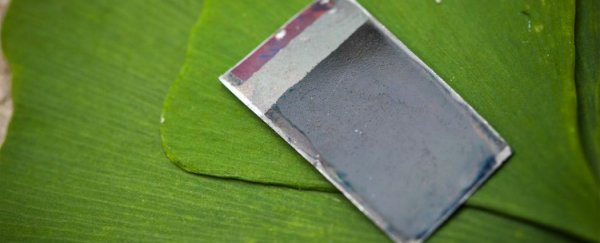In late 2011, chemist David Nocera from the Massachusetts Institute of Technology (MIT) introduced the world to his 'artificial leaf' - a silicon solar cell device that can produce energy using nothing but sunlight and water. The device is steeped in water, and when sunlight beams down on it, it splits the water into hydrogen and oxygen molecules that can be stored as an energy source. This is just what an actual leaf does, except Nocera's cheap little invention can do it 10 times faster.
The stored energy can then be fed into a fuel cell to produce electricity. "With a single gallon of water (3.7 litres), Nocera says, the chip could produce enough electricity to power a house in a developing country for an entire day," Mark Brown reported for Wired, back when it was unveiled. "Provide every house on the planet with an artificial leaf, and we could satisfy our 14-terrawatt need with just one gallon of water a day."
It sounded really promising at the time, but there's one big problem - "You guys don't have an infrastructure to use hydrogen," Nocera told Christina Nunez at National Geographic. "You guys," as in, the world outside the lab. Which is true - while electric cars are being built to run on hydrogen gas, petrol stations around the world aren't rushing to install new vapour-friendly pumps. They're sticking with their good, old-fashioned liquid pumps for now.
So the question Nocera asked himself was, 'Can I invent a device that converts hydrogen gas into a something other than electricity, say, a liquid fuel?'
The answer, he found, lies in engineered Ralstonia eutropha bacteria, which can take hydrogen molecules - either from Nocera's artificial leaf, or something similar - and convert them into a form of liquid fuel. According to the paper, published this week in the Proceedings of the National Academy of Sciences, the bacteria are able to absorb the hydrogen molecules, split them into their base protons and electrons, and combine them with carbon dioxide.
The bacteria have specially engineered metabolic pathways that can then convert this hydrogen-carbon dioxide blend into an alcohol-based fuel called isopropanol, which is sort of like ethanol.
Nunez reports at National Geographic that the idea would be to set up a bacteria 'farm' to produce this fuel in bulk, sort of like an algae farm, but the bacteria will be much cheaper to maintain because they don't need a continuous light source or much hands-on care to survive.
The team is only in the beginning stages of developing something that could feasibly be put on the market, and their most pressing challenge is to up the efficiency of the system. "We're almost at a 1 percent efficiency rate of converting sunlight into isopropanol," Nocera says in the press release, which is about the same rate that's found in nature when a plant uses photosynthesis to convert sunlight into biomass.
They're working on increasing their efficiency to 5 percent. "There have been 2.6 billion years of evolution, and Pam [Silver, from Harvard] and I working together a year and a half have already achieved the efficiency of photosynthesis."
Source: National Geographic
